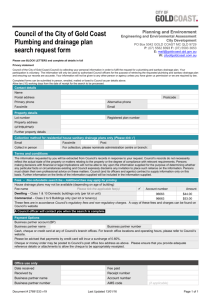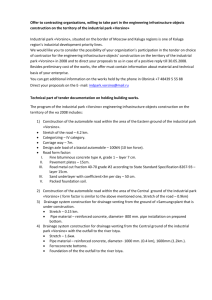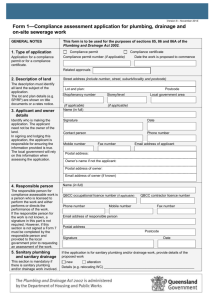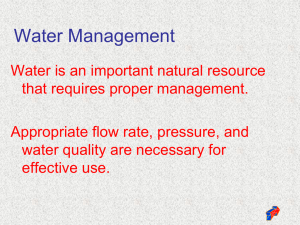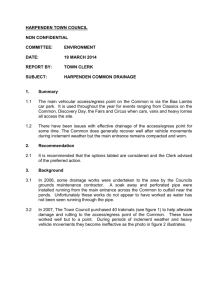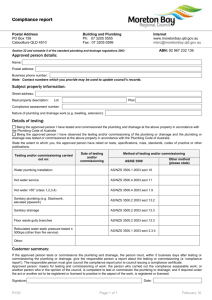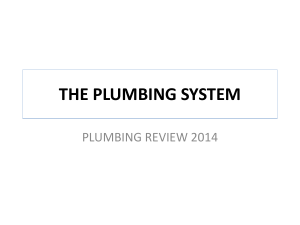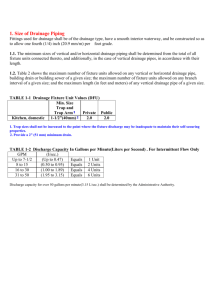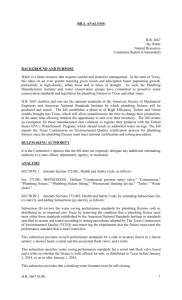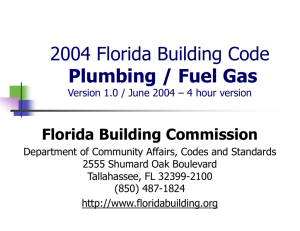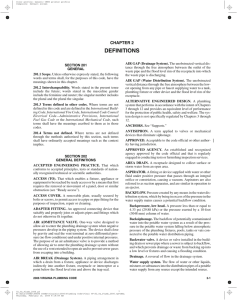Residential Plumbing Code Requirements
advertisement
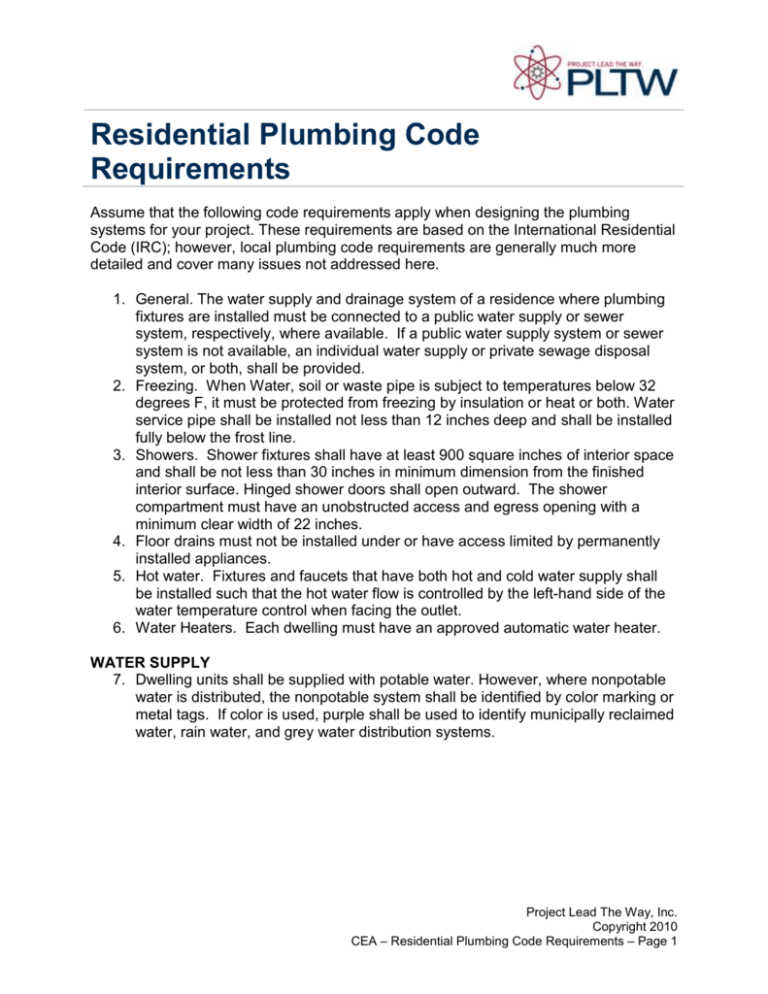
Residential Plumbing Code Requirements Assume that the following code requirements apply when designing the plumbing systems for your project. These requirements are based on the International Residential Code (IRC); however, local plumbing code requirements are generally much more detailed and cover many issues not addressed here. 1. General. The water supply and drainage system of a residence where plumbing fixtures are installed must be connected to a public water supply or sewer system, respectively, where available. If a public water supply system or sewer system is not available, an individual water supply or private sewage disposal system, or both, shall be provided. 2. Freezing. When Water, soil or waste pipe is subject to temperatures below 32 degrees F, it must be protected from freezing by insulation or heat or both. Water service pipe shall be installed not less than 12 inches deep and shall be installed fully below the frost line. 3. Showers. Shower fixtures shall have at least 900 square inches of interior space and shall be not less than 30 inches in minimum dimension from the finished interior surface. Hinged shower doors shall open outward. The shower compartment must have an unobstructed access and egress opening with a minimum clear width of 22 inches. 4. Floor drains must not be installed under or have access limited by permanently installed appliances. 5. Hot water. Fixtures and faucets that have both hot and cold water supply shall be installed such that the hot water flow is controlled by the left-hand side of the water temperature control when facing the outlet. 6. Water Heaters. Each dwelling must have an approved automatic water heater. WATER SUPPLY 7. Dwelling units shall be supplied with potable water. However, where nonpotable water is distributed, the nonpotable system shall be identified by color marking or metal tags. If color is used, purple shall be used to identify municipally reclaimed water, rain water, and grey water distribution systems. Project Lead The Way, Inc. Copyright 2010 CEA – Residential Plumbing Code Requirements – Page 1 8. The water service distribution system shall provide capacities under peak demand at the point of outlet discharge not less than the following. REQUIRED CAPACITIES AT POINT OF DISCHARGE FIXTURE AT POINT OF FLOW RATE (gpm) FLOW PRESSURE (psi) OUTLET Bathtub 4 20 Dishwasher 2.75 8 Lavatory 4 8 Shower 3 20 Sink 2.5 8 Water closet, tank, one6 20 piece 9. The maximum capacities for plumbing fixtures are shown below. MAXIMUM FLOW RATES AND CONSUMPTION FOR PLUMBING FIXTURES AND FITTINGS FIXTURE OR FITTING MAXIMUM CAPACITY Lavatory faucet 2.2 gpm at 60 psi Shower head 2.5 gpm at 80 psi Sink faucet 2.2 gpm at 60 psi Water closet 1.6 gallons per flushing cycle 10. Minimum pressure. Minimum static pressure at the building entrance shall be 40 psi. 11. Maximum pressure. Maximum static pressure shall be 80 psi. When main pressure exceeds 80 psi, a pressure-reducing valve shall be installed. DRAINAGE 12. Dead ends are prohibited in drainage pipe except for cleanouts. 13. The size of the drainage pipe shall not reduce in the direction of flow. 14. Horizontal drainage pipe shall be installed to maintain a slope not less than ¼ inch vertical in 12 inches vertical (2 percent slope). 15. Drain pipe shall be sized based on the drainage fixture unit (d.f.u.) loads. 16. Drainage Fixture Units (d.f.u.) values for plumbing fixtures are given in the table below. DRAINAGE FIXTURE UNITS FOR FIXTURES TYPE OF FIXTURE DRAINAGE FIXUTRE UNIT VALUE (d.f.u.) Bathtub 2 Clothes washer 2 Dishwasher 2 Floor drain 0 Kitchen sink 2 Project Lead The Way, Inc. Copyright 2010 CEA – Residential Plumbing Code Requirements – Page 2 Lavatory Shower stall Water closet 1 2 4 17. The building drain and sewer size and slope shall be determined from the table below based on drainage load in fixture units (d.f.u.). No pipe providing drainage for a water closet shall be less than 3 inches in diameter. MAXIMUM NUMBER OF FIXTURE UNITS ALLOWED TO BE CONNECTED TO BUILDING DRAIN OR BUILDING SEWER PIPE DIAMETER (in.) 2a 2 ½a 3 4 a. No water closets included. SLOPE PER FOOT ¼ inch 21 24 42 216 ½ inch 27 31 50 250 VENTS 18. In climates where the 97.5-percent value for outside temperature is 0 degrees F or lower, vent pipes on installed on the exterior of the dwelling shall be protected from freezing by insulation, heat or both. 19. Open vent pipes that extend through the roof of the structure shall extend a minimum of 6 inches above the roof or 6 inches above the anticipated snow accumulations, whichever is greater. If the roof is used for anything other than protection from the weather (for instance equipment placement, a deck, etc.) the vent pipe must extend at least seven feet above the roof. Project Lead The Way, Inc. Copyright 2010 CEA – Residential Plumbing Code Requirements – Page 3
